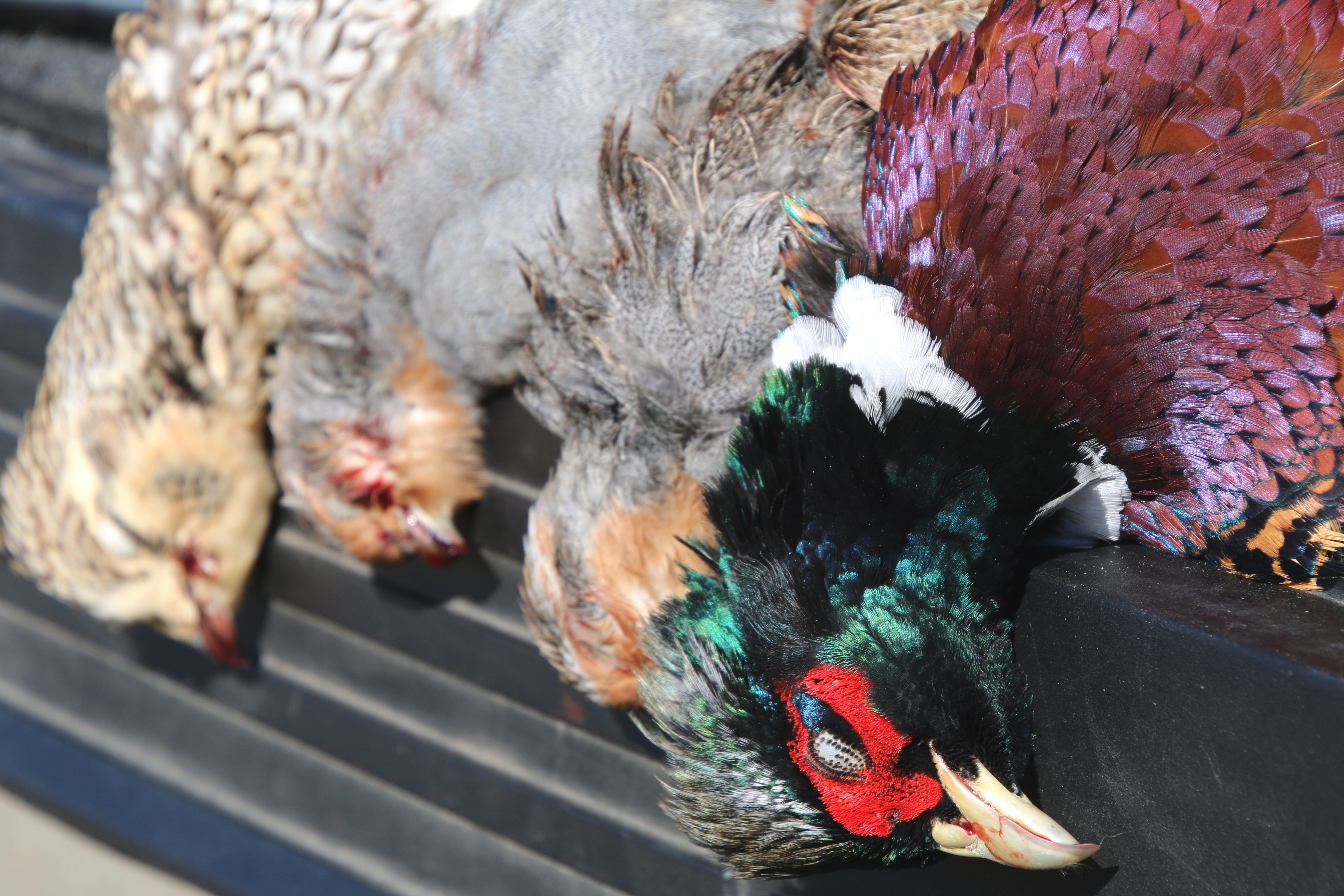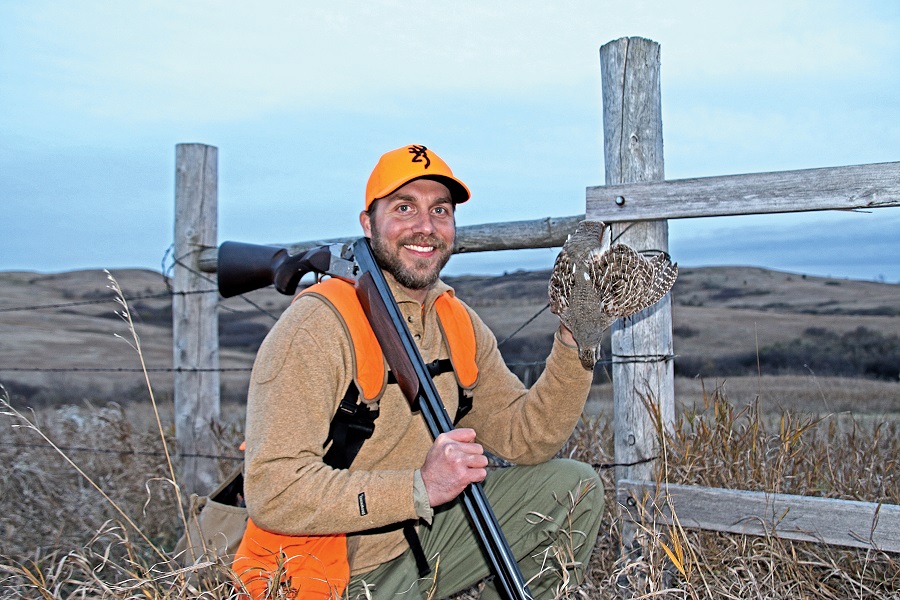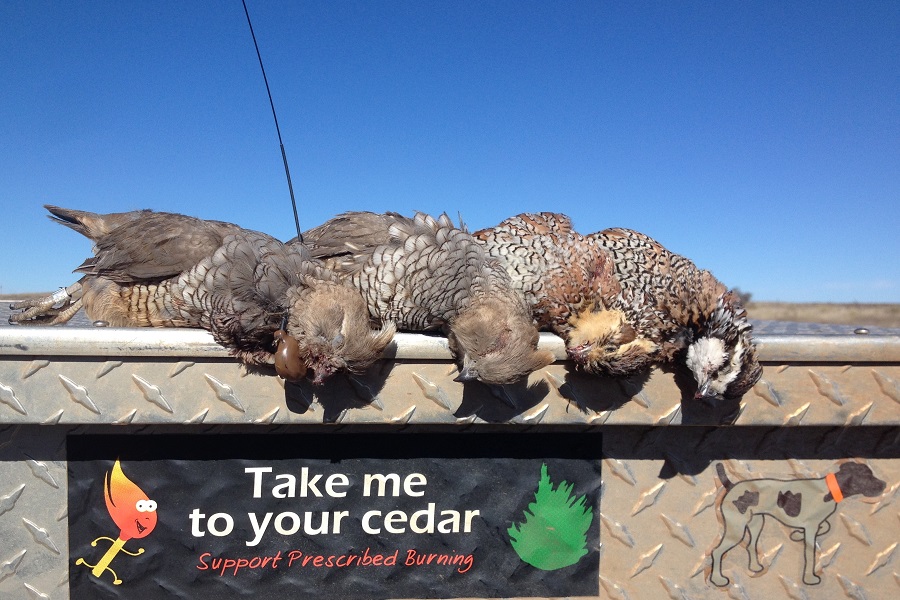While the thrill of a rooster pheasant flushing at your feet never gets old, there is something to be said about changing things up from time to time, and the following list highlights 15 hunts where you can mix it up this fall.
Lights, Camera, Lemmon
Upland bird hunters know that there is more to Lemmon, S.D. than its connection to Hugh Glass and the new blockbuster hit “The Revenant.” Rolling hills of grassland habitat, edge cover along the perimeter of grain fields and thousands of acres of public hunting all combine to make this small town in northwestern South Dakota an A-list mixed-bag destination.
“This area is well known for producing great hunting for pheasants and sharptail grouse,” says Travis Runia, upland bird biologist with the South Dakota Game, Fish & Parks. “And the region is probably your best bet for shooting a Hungarian partridge in the state.”
Ought to Give Iowa a Try
With improving pheasant numbers and a bobwhite quail population at a 20-year high, Iowa holds real promise for putting together a mixed-bag hunt.
Your best bet to put a gentleman bob and wily rooster in the game bag on the same day will be found in the southern tier of counties, says Todd Bogenschutz, an upland biologist with the Iowa Department of Natural Resources.
“Iowa is on the northern fringe of quail country, so hunting the right blend of habitats is key to finding those pockets of bobwhites,” says Bogenschutz. “What you want to look for are those farms where you can transition from upland cover to shrubby edge habitat to cropland.”
A North Dakota Upland Trifecta
The grassy field edges, grain fields and grassland found in western North Dakota make the region an upland wonderland for pheasants, sharp-tailed grouse and Hungarian partridge.
Shooting a limit of all three species in the same day is no easy task, according to North Dakota Game and Fish Department upland biologist, Aaron Robinson, but it is possible. Centering in on the right mix of habitat is key to getting it done.
“Pheasants and sharptails are more common in western North Dakota, so the trick can be finding those areas with that edge mix – from weedy field corners to rangeland – that are so good for Huns,” says Robinson. “You have to cover some country to complete this mixed bag.”
.JPG.aspx) Rangeland Roosters, Bobwhites and Prairie Chickens
Rangeland Roosters, Bobwhites and Prairie Chickens
Like so many programs supported by Pheasants Forever, the benefits of southwestern Nebraska’s Focus on Pheasants Initiative extend well beyond limits of long-tailed roosters in the game bag.
Pheasants Forever Farm Bill biologist Andy Houser says the research-driven initiative, which provides incentives to producers to implement and manage habitat within their working cattle, wheat and milo operations, is helping conservation-minded landowners increase populations bobwhite quail and prairie chickens as well as pheasants.
“And what makes the initiative a win-win for everyone is that the programs are often coupled with creating public access, so hunters are seeing more birds and finding more places to chase them, too,” Houser says.
Potter County Mixed-Bag
South Dakota is blessed with many areas boasting high numbers of pheasants, but rare are those places where exceptional pheasant country overlaps with the habitat preferred by prairie grouse. Potter County is such a place.
Located in north-central South Dakota, Potter County is home to sunflowers, corn, wheat, grass, and loads of birds.
“If you’re thinking of making a trip out here, I’d recommend taking a look at a hunt a little later in the season, really anytime in November,” says Mark Braaten, hunting manager at Brown’s Hunting Ranch near Gettysburg. “The pheasants and grouse are starting to bunch up more and the temperatures are cooler, which makes it much easier on the dogs.”
Upland Bliss in Hells Canyon
The rugged terrain that ascends from the waters of the Snake River along the Idaho-Oregon border is known as Hells Canyon, and it truly contains the makings of an upland hunt that is out of this world.
The hunting is not for the faint of heart, cautions Bill Sherck, co-host of “The Flush” on the Outdoor Channel, but it remains one of his favorite places to go after a mixed bag that includes pheasants, Hungarian and chukar partridge and even a chance at California quail.
“The landscape and the scenery are like nothing I’ve ever seen, and really the entire experience is just unique,” says Sherck. “You use a jet-boat to get up the river, and since much of the ground bordering the river is public, you stop the boat wherever you spot birds or the right kind of cover, hop out and start hunting.”
 Mix It Up Near Hub City
Mix It Up Near Hub City
Booming success following the construction of multiple rail lines helped earn Aberdeen, S.D. the nickname of “Hub City,” and thousands of acres of habitat and public access keep hunters riding the rails into town each fall.
You can choose to travel just about any direction from Aberdeen and find multiple options for a day in the field, says Casey Weismantel with the Aberdeen Convention and Visitors Bureau.
“There are pheasants in every direction, and from there it is pretty easy to add waterfowl, sharp-tailed grouse or even great fall fishing if you want to mix things up,” says Weismantel. “South Dakota contains such a wide variety of habitats, and the mixed-bag experience helps you enjoy it all.”
Unique Kansas Combo
An improved pattern of weather has helped boost upland bird numbers in northwest Kansas – an area valued by the do-it-yourself upland hunter because of the wide swaths of ground enrolled in the state’s Walk-In Hunting Access program located in this region.
From fields of milo to rolling hills of grass to rugged draws, the area consists of varied habitats, says Scott Carlson of Atwood-based Carlson’s Choke Tubes, which helps explain why hunters can bag a variety of birds in one day, including pheasants, bobwhite quail…and turkeys.
“Tagging a fall turkey makes for a unique twist to a fall hunt, that’s for sure,” says Carlson. “And if you find turkeys, most landowners are more than happy to have you hunt them.”
Partridge and More in Southern Saskatchewan
U.S. residents are prohibited from participating in Saskatchewan’s pheasant season, but don’t let that keep you for making a trip to the southern reaches of the province for a fantastic mix of sharp-tailed grouse, Hungarian partridge and waterfowl.
Upland bird numbers are climbing back up to levels seen prior to a series of hard winters, says Chad Morris with Saskatchewan Outdoors Outfitting, meaning hunters will commonly encounter coveys of 15-20 Hungarian partridge and 30-40 sharp-tailed grouse throughout the day.
“On top of the upland hunting, we have tremendous walleye fishing in the fall, and most people are well aware of the kind of duck and goose hunting found here,” says Morris, who recommends a trip between the third week in September and the second week of October. “You really just have to get up here and see it to understand how good it really is.”
 A Capital Mix
A Capital Mix
With the 100,000-acre Ft. Pierre National Grasslands and numerous other public and private hunting options within a short drive of Pierre, S.D., there may be few destinations that provide a better chance to complete a mixed-bag hunt than this capital city along the Missouri River.
Pheasants, prairie chickens, sharp-tailed grouse, and waterfowl are all possible for hunters near Pierre, and veteran guide Dave Spaid also recommends adding a wet twist.
“With so much good hunting close to the Missouri River, the Pierre area is tailor-made for a cast-and-blast combo,” says Spaid. “Not only can the fishing be great, but it gives hunters a chance to relax and unwind while taking in the beautiful scenery of the Missouri River.”
Big Sky Upland Opportunities
If the sight of seven mountain ranges, rolling fields of wheat stubble, and streams of cold, clean water aren’t enough to get you excited about a visit to central Montana, then maybe the chance at shooting up to five different species of upland birds will be.
The hard-flying Hungarian partridge are a top draw for hunters to the varied topography found near Lewistown, but Pete Rogers with Pigeye Outfitters says that pheasants and three types of grouse – sharp-tailed, ruffed, and blue – are also viable options during a multi-day hunt.
“After a day or two of chasing grouse, partridge and pheasants, it’s kind of nice to escape to the higher elevations for the mountain birds,” says Rogers. “Ruffed grouse are pretty popular, but the blue grouse is probably one of my favorites; a beautiful bird that is hard to beat on the plate.”
Southeastern Colorado Quail and Roosters
The extreme southeastern corner of Colorado is home to some of the state’s most consistent action for pheasants, bobwhite and scaled quail.
The birds are supported by a series of successful conservation programs that have boosted habitat in the area, says Pheasants Forever Farm Bill biologist Cody Strong, including State Acres for Wildlife Enhancement (SAFE) and CP33 (Quail Buffers).
“For the best success, hunters will want to focus on those areas where this habitat is situated adjacent to cropland,” says Strong. “Fortunately, that includes many of those acres that open to public access through the state’s Walk-In Area program, which are found throughout this region.”
 Cornhusker Bobwhites and Pheasants
Cornhusker Bobwhites and Pheasants
Thanks to the establishment of habitat and a little help from Mother Nature, bobwhite quail numbers have rebounded in Nebraska to levels not seen in two decades, says Jeff Lusk with the Nebraska Game and Parks Commission.
“The bobwhite quail have bounced back even faster than the pheasants,” says Lusk. “But you’ll find good numbers of both, particularly in the southeast corner of the state.”
Lusk points to the Tecumseh and Beatrice areas as places where hunters will find the right mix of brushy and grass habitats that support pheasants and bobwhites.
“And those areas also have a fair amount of ground that is open for public access,” he says.
Late-Season Combo at LaCreek
The first few weeks of the pheasant season can be busy on the public ground near LaCreek Wildlife Refuge in southwest South Dakota, but refuge manager Brian DeVries says that patience pays for those hunters who travel later in the year.
“The hunting pressure slows considerably,” says DeVries. “And the number of sharp-tailed grouse seems to build as the season progresses – a micro-migration of sorts, as the birds shift to the habitat found on and near the refuge. This is a pretty unique area, and later in the season there are days you can almost have it to yourself.”
Central Kansas Mixed Bag
Big whitetail bucks may take top billing in central Kansas, but rebounding populations of bobwhite quail and pheasants make the heart of the Sunflower State a must-see for upland hunters.
Mike Miller with the Kansas Department of Wildlife, Parks and Tourism recommends a mid-December stop in Barton, Stafford, Pawnee, Edwards, Pratt or Kiowa counties, where hunters will find public access and plenty of targets.
“By this time of the year, the hunting pressure has dropped, but bird numbers are still high,” says Miller. “Better yet is if the weather has cooled off and there is maybe a little snow on the ground to improve scent conditions and concentrate the birds.”
Story by John Pollmann
Photos by Anthony Hauck and Logan Hinners of Pheasants Forever and Quail Forever